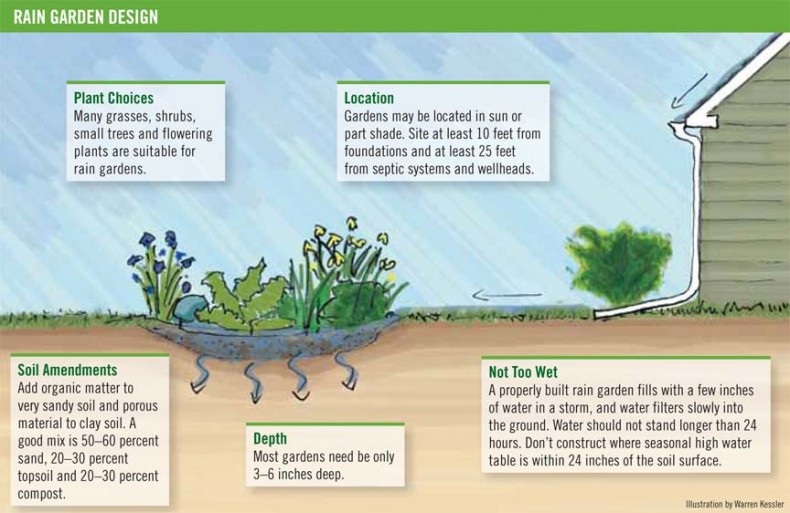Rain Gardens
By Carla Burgess
A rain garden is a way to treat water on your property as an asset rather than diverting all of it somewhere else. Rain gardens are popular among urban planners because they not only slow the flow of runoff into storm drains, rivers and lakes, but also function as traps for retaining and often neutralizing pollution in runoff. Rain gardens also help recharge groundwater in residential and community wells and aquifers.
A rain garden isn't a pond or wetland—it's not meant for cattails and water lilies. A properly constructed one holds water no more than a couple of days, just long enough for water to soak slowly into the ground. Plants in rain gardens must be versatile, able to tolerate temporary inundation as well as brief periods of dry weather. A thoughtfully designed rain garden should draw attention to its beauty, not its function. It can be a bed or border, any shape or size. A wide variety of grasses, shrubs, trees and flowering plants will thrive in rain gardens.
You don't have to hire an engineer to plan a rain garden, but you do need to evaluate and understand where and how water flows across your property. It's helpful to survey and observe your property during and after a storm. Ideally, you'll build a garden sized to capture most or all of the runoff you have—hard surfaces such as roofs and paved sidewalks and driveways are major sources. Any size garden, however, is beneficial, but you still need to plan the size before you start digging. The handy reference chart at this website can help you calculate your runoff amount and decide on garden dimensions.
Depending on the size garden you're building and how many extra hands are about, you could construct a rain garden in as little as an afternoon.
Depending on the size garden you're building and how many extra hands are about, you could construct a rain garden in as little as an afternoon. Most gardens need be only 3 to 6 inches deep. To avoid compacting the soil, use the least destructive tools necessary to excavate. Shovels or tillers may suffice to create the desired saucer-shaped depression. On slopes, you'll need to create a slight berm to help retain water, but don't make it so substantial that it turns your garden into a sediment trap or puddle.
It's best to use plants from containers or fairly mature bare-root plants, rather than sowing seed directly. This will lessen competition with weeds and create a lower-stress environment to become established. Plant as you would any other garden, keeping the plant's crown level with the soil surface. Top with about 2 to 4 inches of organic, heavy hardwood mulch (pine straw or bark may wash away too quickly). Don't pile or spread mulch around the bases of plants. Water well and regularly until roots are well established. (See Rain Gardening Resources for suggestions of appropriate plants.)
Once built, a rain garden can be a low-maintenance garden, but it's not a no-maintenance garden. Rain gardens need to be mulched regularly to hold soil in place and provide a continual source of organic material. The garden may also need periodic weeding to keep it from becoming overgrown. Supplemental watering may be necessary during the establishment stage and sustained droughts. A few stepping stones for access will help you avoid trampling and compacting soil.
Rain Garden Musts:
- Choose a site that is at least 2 feet from the high-water table. If the soil surface in the garden is near the water table, a wetland garden is more appropriate.
- Locate the garden at least 10 feet from a house foundation and at least 25 feet from a septic system field or wellhead.
- Determine the location of underground utility lines to avoid disturbing them.
- Ensure that rain gardens won't direct any water toward a building.
Rain Gardening Resources
The N.C. Cooperative Extension has an online clearinghouse of information on rain gardens, including instructions for design and planting, lists of plant species appropriate for Piedmont, mountain and coastal plain regions, suggestions of plants for both sunny and shady gardens, sample design templates, and construction photos. Find resources at NC Cooperative Extension and more sample designs at Low Impact Development.
In "Rain Gardening in the South" (April 2009), authors Helen Kraus and Anne Spafford, professors of horticultural science at N.C. State University, describe their own experiences designing and building rain gardens. The book contains color photos, a few sample designs and a 20-page reference section of suggested plant species. Available from Eno Publishers (www.enopublishers.org).
Many public gardens, municipalities and educational facilities have built rain gardens to handle their own runoff and to educate and inspire gardeners. To find demonstration gardens in your area, check with your local extension office.
-
Share this story:




Comments (2)
W |
September 26, 2020 |
reply
Carolina Country |
September 28, 2020 |
reply